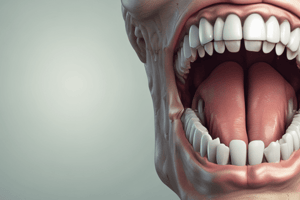Podcast
Questions and Answers
At what stage does the successional lamina develop lingual extensions?
At what stage does the successional lamina develop lingual extensions?
- Cap stage (correct)
- Bud stage
- Calcification stage
- Bell stage
Which tooth is the only permanent tooth to calcify prenatally?
Which tooth is the only permanent tooth to calcify prenatally?
- Maxillary lateral incisor
- Maxillary first molar
- Maxillary central incisor
- Mandibular first molar (correct)
What happens if a deciduous tooth is congenitally missing?
What happens if a deciduous tooth is congenitally missing?
- The adjacent teeth compensate and grow larger
- The adjacent teeth compensate and grow smaller
- The succeeding tooth forms but with delayed calcification
- The succeeding tooth usually will not form (correct)
During which phase does the formation of a tooth's root begin?
During which phase does the formation of a tooth's root begin?
What may develop if an insult occurs during apposition and maturation stages of tooth development?
What may develop if an insult occurs during apposition and maturation stages of tooth development?
Flashcards
Cap Stage
Cap Stage
The stage of tooth development where lingual extensions appear in the enamel organ.
Mandibular First Molar
Mandibular First Molar
This is the only molar that starts to mineralize before birth.
Congenital Missing Deciduous Tooth
Congenital Missing Deciduous Tooth
If a baby tooth is missing, the permanent tooth replacing it may not form.
Bell Stage
Bell Stage
Signup and view all the flashcards
Hypoplasia and Dysplasia
Hypoplasia and Dysplasia
Signup and view all the flashcards
Study Notes
Tooth Development
- Odontogenesis, or tooth development, begins in the early embryonic stages and continues after birth.
- Teeth form in a corono-apical direction and are derived from ectoderm from the first arch and ectomesenchyme from neural crest cells.
Developmental Stages
- By day 23 of gestation, the paired mandibular and maxillary, as well as the medial nasal process, have become distinct.
- The dental lamina first appears at 25 days of gestation in the dog embryo.
- By day 30, the laminae of the left and right arches fuse to make a continuous arch.
Tooth Germ Components
- The components of the tooth germ are the dental papilla, enamel (or dental) organ, and dental follicle.
Origins of Tooth Germ Components
- The enamel organ, oral epithelium, and dental lamina originate from the outer embryonic germ layer known as ectoderm.
- The dental papilla and sac originate from the mesoderm.
Differentiation of Enamel Organ
- Differentiation of the enamel organ for deciduous dentition begins at about day 30 and progresses through the following sequence of stages: bud, early cap, cap, advanced cap, early bell, and advanced bell.
Functions of Enamel Organ and Dental Papilla
- The enamel organ gives rise to or is responsible for root formation, primary epithelial attachment, enamel, and crown patterning.
- The dental papilla gives rise to or is responsible for crown patterning, dentin, and pulp.
Studying That Suits You
Use AI to generate personalized quizzes and flashcards to suit your learning preferences.
Description
Test your knowledge on the process of odontogenesis, or tooth development, which starts in the early embryonic stages and continues after birth. Learn about the formation of teeth and their genetic determinants.




